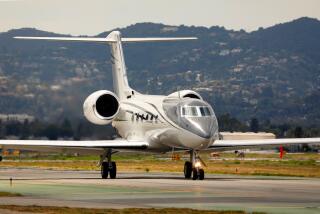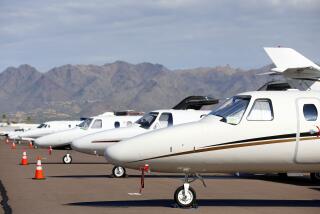The rich are flying again — in the comfort of their private jets
- Share via
The pandemic has sent demand for commercial airline flights into a tailspin, but business is soaring for the private jet companies that fly corporate bigwigs and deep-pocketed travelers looking to wing away to an exclusive getaway.
The trend demonstrates once again that the outbreak of COVID-19 is having vastly different effects on Americans depending on the size of their bank accounts.
Despite the pandemic’s severe blow to flying and the economy, private jet companies such as XO jets, NetJets and Surf Air report that they are booking about 80% as many flights and hours in the air as they had before the pandemic struck the U.S. And many of those fliers are new to the private jet scene.
Meanwhile, demand for flights on traditional airlines has sunk to as low as 10% of pre-pandemic levels — a drop so severe that United Airlines recently served notice that it may furlough up to 36,000 employees.
The reason is clear: Fliers who charter a plane usually get an entire jet to themselves, avoiding a crowded airport terminal and a cramped airline cabin with hundreds of potential virus sources.
“It’s people’s health concerns,” said Patrick Gallagher, president of sales and marketing for NetJets, a jet charter business owned by Berkshire Hathaway. “People are fearful of a commercial terminal with a hundred-plus strangers. They don’t want to deal with the protocols involved in that.”
Gallagher and others in the private jet industry say many of their new bookings and membership accounts are from travelers who previously flew first or business class on traditional airlines and are now switching to lower their risk of contracting COVID-19.
Another reason for the shift is that hard-hit commercial airlines have cut service to many midsize cities. Fliers with fat wallets are booking private jets to fly to small and midsize cities where they own a vacation home or a ski condo.
Because the pandemic has brought most in-person business meetings to a halt, most of the flights taken on private jets have been for leisure, according to private jet operators.
Among the most popular routes for aviation firm VistaJet are New York to Palm Beach, Fla., and Los Angeles to Aspen, Colo.
The wealthiest Americans have found ways to reduce the risk and stress caused by the pandemic, which has already killed more than 130,000 people nationwide: buying private bunkers and shelters, escaping to rural getaways and hiring private tutors for their children while they work from home. Low-wage workers, meanwhile, face a bleaker choice: show up to work — often in high-exposure jobs — and risk being infected, or quit and try to figure out how to make ends meet without a paycheck.
Upgrading to a private jet is not cheap.
The price of a round-trip, first-class flight from Los Angeles International Airport to Las Vegas’ McCarran International Airport is less than $400 on United Airlines. Chartering a small private jet that can carry up to eight passengers from L.A. to Sin City starts at about $9,000 and increases with the size of the jet and the amenities included.
There are several ways to fly on a private jet without owning one.
In addition to simply chartering a private jet to fly from point A to point B, some jet operators offer “fractional” jet ownership, in which the client pays for a share of the jet for as long as the contract continues, usually three to five years.
A client who wants to buy one-eighth of a $20-million jet, for example, would pay $2.5 million. During the contract, the fractional owner gets access to the plane for a set number of hours, depending on the size of the share. They must also pay management fees and an hourly rate that goes toward the pilot’s salary and insurance and fuel costs, among other expenses. At the end of the contract, the fractional owner gets back one-eighth of the remaining value of the jet.
Fliers can also sign up for a jet membership program, in which they pay a fee for a limited set of hours in the jet, with pilots and flight attendants included. Sentient Jet, based in Massachusetts, offers an entry-level program with 25 hours of jet time for $137,000. A jet with a larger cabin and Wi-Fi access costs $196,000 for 25 hours of flight.
Santa Monica-based Surf Air is an all-you-can-fly membership program that charges $1,950 per month to fly as often as you like on pre-scheduled routes to such destinations as San Francisco, Santa Barbara, Las Vegas and Lake Tahoe.
Private jet operators saw an immediate surge in demand after the pandemic reached the United States and government officials began to impose stay-at-home orders. Americans traveling abroad and students away from home in college turned to private jets to return home when travel restrictions led airlines to cancel thousands of flights between Europe and the U.S.
After demand for all air travel dropped off in April, private jet operators say they saw an unprecedented surge in business that has nearly returned the private jet charters to pre-pandemic levels.
“I’ve never seen this before,” said Andrew Collins, president and chief operating officer of Sentient Jet. “We just saw the most new customers we have ever seen in June.”
Gogo Business Aviation, which provides broadband service for private jets, reported that in mid-April the number of flights using its service dropped to 378 per day but then jumped to 3,200 per day by the beginning of July. Before the pandemic, about 3,500 flights used its service daily.
Leona Qi, the U.S. president of VistaJet, said more than two-thirds of the incoming calls to her business are from people who have never flown on a private jet before.
Michael Cappuccitti, a land developer from Toronto, turned to a private jet this spring after he and his family flew to Barcelona on a commercial flight to have his daughter undergo back surgery. Once the pandemic reached North America, travel restrictions made it nearly impossible for the family to fly back to Canada on a commercial airline. Cappuccitti chartered a private jet at a slightly discounted rate to fly back to Toronto.
Although he had previously flown first or business class on American Airlines for business trips, Cappuccitti said he was awed by the service and luxury of the private jet and has now set a goal of someday being able to afford to fly on a private jet on a regular basis.
“The experience reinforced everything I thought about it,” he said. “It was ridiculous how good it was.”
But for most new private jet fliers, the attraction of a private jet is the reduced exposure to other fliers and places where the coronavirus might be lurking.
Although commercial planes have a ventilation system that keeps air from circulating through the entire length of the cabin, health experts say the more crowded a plane cabin, the greater the risk of being infected. In a private jet, the client controls who and how many people share the cabin.
Private jet passengers also get to avoid going through a crowded airport terminal before boarding, another potential avenue of exposure to the virus.
Operators say they have not been promoting or advertising the reduced potential for exposure to COVID-19 on private jets. They say they don’t have to.
“Ultimate luxury is peace of mind,” NetJets’ Gallagher said. “People in the market for private aviation understand that.”
More to Read
Inside the business of entertainment
The Wide Shot brings you news, analysis and insights on everything from streaming wars to production — and what it all means for the future.
You may occasionally receive promotional content from the Los Angeles Times.











